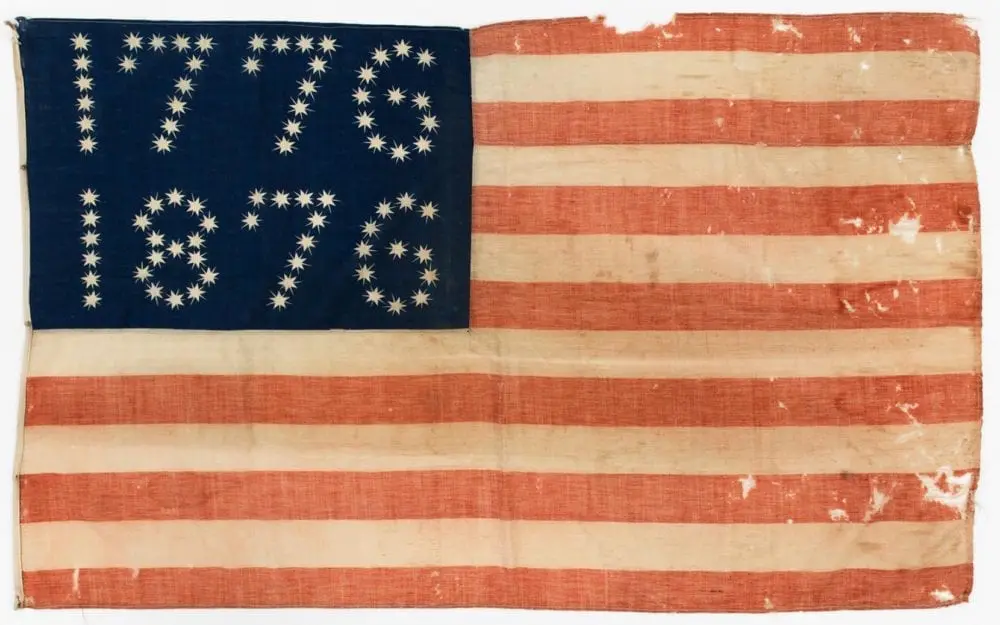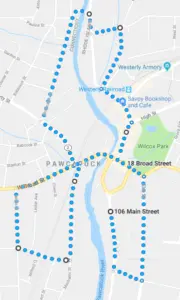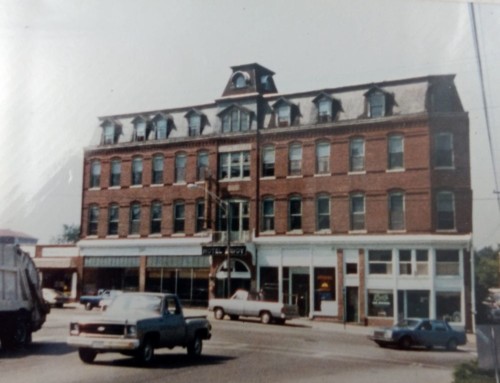As we celebrate the 245th anniversary of the signing of the Declaration of Independence, let us look back at how Westerly celebrated the American Centennial on July 4, 1876.
Leading up to the big day, it was apparent to all that there should be a momentous celebration. In the weeks prior to July 4, the Westerly Town Council voted and approved several measures, including granting permission to Everett Barnes and others to “ring handbells on the streets of this village on the morning of July 4, 1876 from 4-5 p.m or longer.”[1]
Additionally, the council granted permission to all persons who wished to light fireworks on the property of the heirs of Rowse Babcock, east of Grove Avenue (today in Wilcox Park), and the land of Edward F. Vose on High Street.[2] In the event that the festivities got out of hand, the Town Council also appointed a special police unit to “preserve order at the Westerly Driving Park.” This police unit was to serve without pay.[3]
The Centennial celebration began early in Westerly, as one review noted: “At 4 o’clock in the morning, all the bells of the village commenced ringing, which was kept up for half an hour. Then a company of boys drove through the principal streets of the village, ringing bells and blowing horns.”[4] Later, at 8 o’clock, a parade of “Antiques and Horribles,” a form of parade which developed in New England in the 1850’s and was meant to satirize politicians and public figures, began.[5]
The Westerly parade, however, was more comical and self-deprecating. The procession was led by a man imitating President Ulysses S. Grant. This was followed by a replica of the famous Antietam statue with a moveable head and lower jaw which was drawn by eight oxen, as well as a display called “Going to the Centennial” which depicted a husband and wife from the country in a shabby carriage.
The Parade began at Armory Hall (on the land where McQuade’s Marketplace now stands), proceeded through Westerly and Pawcatuck, and concluded at Dixon House Square on Broad Street.[6]
At the parade’s conclusion, the Declaration of Independence was read and followed by an oration delivered by Gideon X. Squills LL.D.[7] The entertainment for the afternoon was then held at the Westerly Driving Park. At noon, a baseball game was played between “a picked nine” and “Our Boys” the latter of which won the contest 12-7.[8]
Following the game, there were horse races which were “characterized by accidents” including two disabled carriages and one runaway horse. The horse owned by W.H. Chapman apparently became frightened at one point and ran into the crowd. Thankfully, there were not any injuries from the incident.[9] The races were attended by upwards of eight hundred people.
Although a sack race was planned for the afternoon, this was changed to a foot race, with a five dollar prize. Closing out the afternoon’s revelries was a tightrope walk by a professor Dernier, who walked over Deep Hollow.[10] The Westerly Brass Band furnished the music throughout the events. As the day turned into night, fireworks, furnished by the Antiques and Horribles Committee and launched from Grove Avenue, concluded the day-long observance.[11]
One intentional absence from the fourth of July celebration in Westerly was alcohol. An article which appeared in the Wood River Advertiser several weeks after the fourth: “there was an almost total absence of any appearance of intoxication during the day, the beer shops were voluntarily closed by their keepers. Only one arrest was made during the day for disorderly conduct.”[12]
There was also a significant, albeit quieter, celebration of the Centennial held in White Rock. The day began with an invocation by Reverend J.G. Noble and was followed by a reading of Declaration of Independence by Reverend John Evans. This then led up to an oration by Reverend C.T. Douglas and a prayer read by J.W. Willetts.[13] After these readings, there was a dinner, a sack race, gymnastics, and a tub race on Pawcatuck Lake, as well as music by the White Rock Band throughout the day.[14]
While the Centennial celebrations in Westerly were certainly exciting for their time, and properly commemorated an important date in our nation’s history, the fourth of July celebrations just twenty-four years later in 1900 showcase just how much progress was made in the late Nineteenth Century. On July 4, 1900 the steamer Martha was run between Westerly and Watch Hill five times throughout the day, and it was said that the electric cars in Watch Hill were constantly full and were run double their usual schedule.[15]
Local merchants were also flooded with customers all day. According to one account “Tribly, the popcorn man, was in his element. All day long his melodious voice told of the food.” The soda fountains in town were also said to have done big business as a result of the intense heat.[16] The heat also led to large crowds at the bathing beaches. Other events of the day included a picnic held by St. Michael’s Church, a celebration for the opening of a new house at the Misquamicut Golf Club, and two baseball games played by the White Rock team at Riverside Park against teams from Wakefield and Jewett City.[17]
While the way in which the Fourth of July is celebrated may have changed since 1876, the sentiments remain the same. On this day, let us celebrate the history of our great nation and of our town which we hold so dear.
[su_accordion class=””] [su_spoiler title=”Footnotes” open=”no” style=”default” icon=”plus” anchor=”” class=””]
[1] Town Council and Probate Records, 1699-1888, Westerly, Rhode Island, vol. 7, pgs. 474-475.
[2] Town Council and Probate Records, 1699-1888, Westerly, Rhode Island, vol. 7, pgs. 474-475.
[3] Town Council and Probate Records, 1699-1888, Westerly, Rhode Island, vol. 7, pgs. 474-475.
[4] “The Centennial Fourth.” Narragansett Weekly, 6 July 1876.
[5] Zimmer, Ben, “Where did the Supreme Court get its ‘parade of horribles’?” Boston Globe, 1 Jul 2012.
[6] “Westerly.” Wood River Advertiser, 23 July 1876 and “Celebrating the Fourth.” Narragansett Weekly, 29 June 1876.
[7] “The Centennial Fourth.” Narragansett Weekly, 6 July 1876.
[8] “The Centennial Fourth.” Narragansett Weekly, 6 July 1876.
[9] “Westerly.” Wood River Advertiser, 23 July 1876.
[10] “Celebrating the Fourth.” Narragansett Weekly, 29 June 1876.
[11] “The Centennial Fourth.” Narragansett Weekly, 6 July 1876.
[12] “Westerly.” Wood River Advertiser, 23 July 1876.
[13] “The Centennial Fourth.” Narragansett Weekly, 6 July 1876.
[14] “The Centennial Fourth.” Narragansett Weekly, 6 July 1876.
[15] “The Glorious Fourth” Westerly Sun, 3 July 1900 and “Watch Hill: A Glorious But Hot Fourth” Westerly Sun, 4 July 1900.
[16] “Fourth of July Boomings” Westerly Sun, 6 July 1900.
[17] “Fourth of July Boomings” Westerly Sun, 6 July 1900 and “St. Michael’s Picnic” Westerly Sun, 4 July 1900 and “Watch Hill: A Glorious But Hot Fourth” Westerly Sun, 4 July 1900 and “The Glorious Fourth” Westerly Sun, 3 July 1900.
[/su_spoiler] [/su_accordion]







